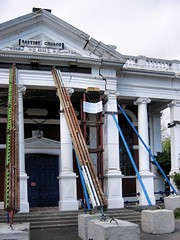
Search
Images for Canterbury earthquake; more images...
Damage on Oxford Terrace
Images, eqnz.chch.2010
Neighbours across the river showing earthquake damage. Hotel Grand Chancellor in the background. File reference: CCL-2011-08-12-CanterburyPublic Library pre-demolition-044 From the collection of Christchurch City Libraries.
Liquefaction Performance & Characterisation of 55 Chrictchurch Sites
Research papers, University of Canterbury Library
To identify key ground characteristics that led to different liquefaction manifestations during the Canterbury earthquakes
BeckerFraserPhotos September 2011 photograph 125
Images, UC QuakeStudies
Photograph captioned by BeckerFraserPhotos, "Canterbury Museum re-opened to the public on the 1st anniversary of the September earthquake, 4 September, 2011".
Damage to Canterbury Public Library building
Images, eqnz.chch.2010
File reference: CCL-2011-08-12-CanterburyPublic Library pre-demolition-001 From the collection of Christchurch City Libraries.
Damage to Canterbury Public Library building
Images, eqnz.chch.2010
File reference: CCL-2011-08-12-CanterburyPublic Library pre-demolition-004 From the collection of Christchurch City Libraries.
NicksPlace Photograph 099
Images, UC QuakeStudies
A fence and Road Closed sign block off an earthquake-damaged road in rural Canterbury.
Shermine Kwok Photograph 84
Images, UC QuakeStudies
A photograph of the view from the office of CERA, the Canterbury Earthquake Recovery Authority.
Damage to the Canterbury Public Library building
Images, eqnz.chch.2010
File reference: CCL-2011-08-12-CanterburyPublic Library pre-demolition-024 From the collection of Christchurch City Libraries.
Damage to the Canterbury Public Library building
Images, eqnz.chch.2010
File reference: CCL-2011-08-12-CanterburyPublic Library pre-demolition-014 From the collection of Christchurch City Libraries.
Damage to the Canterbury Public Library building
Images, eqnz.chch.2010
File reference: CCL-2011-08-12-CanterburyPublic Library pre-demolition-020 From the collection of Christchurch City Libraries.
Damage to old Canterbury Public Library damage
Images, eqnz.chch.2010
File reference: CCL-2011-08-12-CanterburyPublic Library pre-demolition-039 From the collection of Christchurch City Libraries.
Damage to the Canterbury Public Library building
Images, eqnz.chch.2010
File reference: CCL-2011-08-12-CanterburyPublic Library pre-demolition-006 From the collection of Christchurch City Libraries.
Damage to the Canterbury Public Library building
Images, eqnz.chch.2010
File reference: CCL-2011-08-12-CanterburyPublic Library pre-demolition-015 From the collection of Christchurch City Libraries.
Damage to the Canterbury Public Library building
Images, eqnz.chch.2010
File reference: CCL-2011-08-12-CanterburyPublic Library pre-demolition-009 From the collection of Christchurch City Libraries.
Damage to the Canterbury Public Library building
Images, eqnz.chch.2010
File reference: CCL-2011-08-12-CanterburyPublic Library pre-demolition-010 From the collection of Christchurch City Libraries.
Damage to the Canterbury Public Library building
Images, eqnz.chch.2010
File reference: CCL-2011-08-12-CanterburyPublic Library pre-demolition-018 From the collection of Christchurch City Libraries.
Damage to the Canterbury Public Library building
Images, eqnz.chch.2010
File reference: CCL-2011-08-12-CanterburyPublic Library pre-demolition-017 From the collection of Christchurch City Libraries.
Damage to the Canterbury Public Library building
Images, eqnz.chch.2010
File reference: CCL-2011-08-12-CanterburyPublic Library pre-demolition-008 From the collection of Christchurch City Libraries.
Damage to the Canterbury Public Library building
Images, eqnz.chch.2010
File reference: CCL-2011-08-12-CanterburyPublic Library pre-demolition-023 From the collection of Christchurch City Libraries.
Damage to the Canterbury Public Library building
Images, eqnz.chch.2010
File reference: CCL-2011-08-12-CanterburyPublic Library pre-demolition-013 From the collection of Christchurch City Libraries.
Damage to the Canterbury Public Library building
Images, eqnz.chch.2010
File reference: CCL-2011-08-12-CanterburyPublic Library pre-demolition-019 From the collection of Christchurch City Libraries.
Damage to the Canterbury Public Library building
Images, eqnz.chch.2010
File reference: CCL-2011-08-12-CanterburyPublic Library pre-demolition-011 From the collection of Christchurch City Libraries.
Damage to the Canterbury Public Library building
Images, eqnz.chch.2010
File reference: CCL-2011-08-12-CanterburyPublic Library pre-demolition-007 From the collection of Christchurch City Libraries.
Damage to the Canterbury Public Library building
Images, eqnz.chch.2010
File reference: CCL-2011-08-12-CanterburyPublic Library pre-demolition-021 From the collection of Christchurch City Libraries.
Damage to the Canterbury Public Library building
Images, eqnz.chch.2010
File reference: CCL-2011-08-12-CanterburyPublic Library pre-demolition-025 From the collection of Christchurch City Libraries.
Damage to the Canterbury Public Library building
Images, eqnz.chch.2010
File reference: CCL-2011-08-12-CanterburyPublic Library pre-demolition-012 From the collection of Christchurch City Libraries.
Di Madgin's Red Zone photograph 6
Images, UC QuakeStudies
A scanned copy of a photograph of the garden of Di Madgin's former home in the Red Zone, taken before the earthquakes.
Di Madgin's Red Zone photograph 4
Images, UC QuakeStudies
A scanned copy of a photograph of the garden of Di Madgin's former home in the Red Zone, taken before the earthquakes.
Shirley Community Centre, Shirley
Images, eqnz.chch.2010
Shirley Community Centre, Shirley Road, Christchurch. File reference: CCL-2012-05-10-Around-Shirley-May-2012 DSC_02866.JPG From the collection of Christchurch City Libraries.
Shirley Community Centre, Shirley
Images, eqnz.chch.2010
Shirley Community Centre, Shirley Road, Christchurch. File reference: CCL-2012-05-10-Around-Shirley-May-2012 DSC_02862.JPG From the collection of Christchurch City Libraries.



